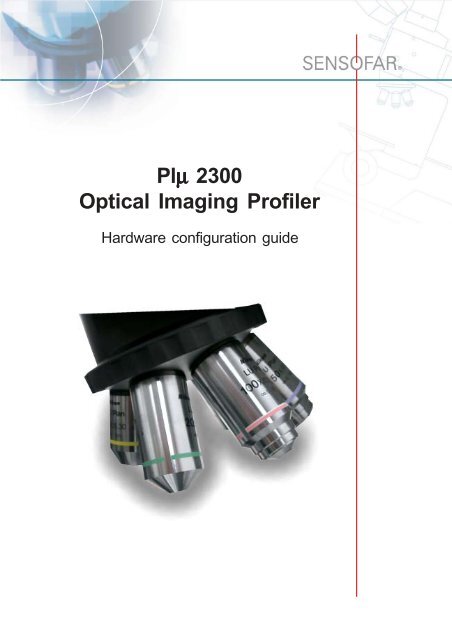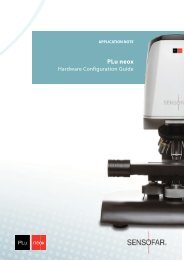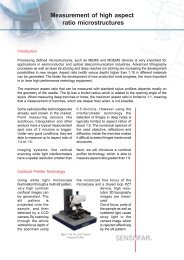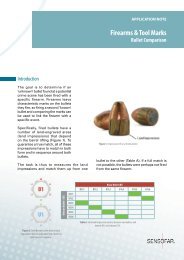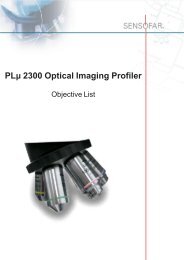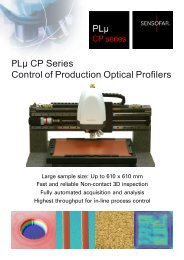Plµ 2300 Optical Imaging Profiler - Sensofar
Plµ 2300 Optical Imaging Profiler - Sensofar
Plµ 2300 Optical Imaging Profiler - Sensofar
You also want an ePaper? Increase the reach of your titles
YUMPU automatically turns print PDFs into web optimized ePapers that Google loves.
Plμ <strong>2300</strong><br />
<strong>Optical</strong> <strong>Imaging</strong> <strong>Profiler</strong><br />
Hardware configuration guide
Hardware configuration guide<br />
Contents<br />
<strong>Sensofar</strong> product overview<br />
PLµ Standard………………………………………………… 3<br />
PLµ <strong>2300</strong>……………………………………………………... 3<br />
PLµ Custom solutions……………………………………..... 4<br />
PLµ 4300……………………………………………………... 4<br />
PLµ 1300……………………………………………………... 4<br />
Hardware configuration<br />
Configuration……………………………………….................. 5<br />
Objectives<br />
Objectives specifications……………………………………… 7<br />
Objectives selection guide……………………………………. 8<br />
PLµ <strong>2300</strong> Stages<br />
Manual XY stage………………………………………............ 9<br />
Motorized XY stage………………………………………........ 9<br />
Motorized XY stage with encoders…………………………... 9<br />
Manual Tip-Tilt stage………………………………………...... 9<br />
PLµ <strong>2300</strong> Nosepieces<br />
Manual nosepieces ………………………………………....... 10<br />
Motorized nosepieces……………………………………….... 10<br />
TI objective adapter.............................................................. 10<br />
PLµ <strong>2300</strong> Sensorhead…...................…………………………………….... 10<br />
PLµ <strong>2300</strong> Column holder<br />
Aluminium column………………………………………......... 11<br />
Granite column……………………………………….............. 11<br />
PLµ <strong>2300</strong> Scanning devices<br />
Basic Z axis motor……………………………………….......... 11<br />
Close-loop PZT scanning device…………………………….. 11<br />
External length gauge……………………………………….... 11<br />
PLµ <strong>2300</strong> Basemounts<br />
Standard breadboard………………………………………..... 12<br />
Active vibration-isolation table……………………………….. 12<br />
Pneumatic vibration-isolation table...................................... 12<br />
PLµ <strong>2300</strong> Calibration<br />
Calibration mirror………………………………………............ 12<br />
Calibration standard………………………………………....... 13
Hardware configuration guide<br />
<strong>Sensofar</strong> product overview<br />
Plμ Standard<br />
PLµ standard is a laboratory oriented<br />
system based on white light confocal<br />
imaging technology. The proprietary<br />
imaging algorithms make the PLµ<br />
able to measure down to 1 nm<br />
repeatability without any vibrationisolation<br />
system. A great variety of<br />
objectives from 10X to 150X can be<br />
chosen with numerical apertures up<br />
to 0.95, being possible to profile<br />
optically smooth surfaces with local<br />
slopes up to 70 degrees. Additional<br />
motorized stages makes possible to<br />
measure several square millimetres<br />
using stitching algorithms.<br />
Plμ <strong>2300</strong><br />
PLµ <strong>2300</strong> is an independent<br />
sensorhead that combines<br />
interferometrical and confocal<br />
techniques. The use of any of the two<br />
techniques is chosen in the optical<br />
profiler just by clicking a button in the<br />
software. When using confocal<br />
objectives the PLµ <strong>2300</strong> has all the<br />
powerful features of the PLµ standard.<br />
While using interferential<br />
objectives, PLµ <strong>2300</strong> use PSI and<br />
VSI interferential technologies to<br />
measure down to 0.1 nm<br />
repeatability.
Hardware configuration guide<br />
<strong>Sensofar</strong> product overview<br />
Custom hardware<br />
The PLµ can be mounted on<br />
sensorhead custom hardware. This<br />
opens the possibility of using it in a<br />
production line or for inspection of<br />
large samples. Confocal imaging<br />
technology is less sensitive to<br />
vibration, allowing the PLµ <strong>2300</strong><br />
sensorhead to be mounted on a<br />
robotic arm.<br />
Plμ 4300<br />
The <strong>Sensofar</strong>’s PLµ 4300 is an optical<br />
profiler for the 3D measurement of<br />
surfaces and thin films. The unique<br />
combination of Interferometrical<br />
optical profiling and Spectroscopic<br />
Reflectometry on the same<br />
sensorhead makes the PLµ 4300 the<br />
only system in the market able to<br />
measure 3D profiles, roughness and<br />
thickness of opaque and transparent<br />
materials with sub-nanometer<br />
resolution.<br />
Plμ 1300<br />
PLµ 1300 is a portable <strong>Optical</strong> <strong>Imaging</strong><br />
<strong>Profiler</strong> capable of measuring 3D<br />
information of technical surfaces with<br />
the use of Interferometric or Confocal<br />
technologies. The sensor has been<br />
designed to have all the optical<br />
components sealed. This allows using<br />
the profiler in dusty environments. PLµ<br />
1300 has been designed for control<br />
of production environments where the<br />
samples are big and heavy and<br />
cannot be moved or cut to be<br />
inspected by a laboratory based<br />
profiler.
Hardware configuration guide<br />
PLµ <strong>2300</strong> Hardware configuration<br />
PLµ <strong>2300</strong> is usually shipped with a<br />
control electronics box containing all<br />
the driving electronics, and the<br />
computer. The system can be<br />
assembled on the top of this<br />
electronics box, but this is not<br />
required. Extension cables can be<br />
ordered for configurations needing<br />
only the sensorhead in a production<br />
line. If the system has to be<br />
assembled on the top of the<br />
electronics box, then there is the<br />
possibility to order a standard<br />
breadboard or an active vibration<br />
isolation sys-tem.<br />
The sensorhead can be mounted<br />
either, on an aluminum column or on<br />
a low thermal expansion granite<br />
column. The sample is placed under<br />
the objective and sitting is on the top<br />
of a manual XY stage on a motorized<br />
stage. For interferometrical<br />
measurements, it is highly<br />
recommended to use a Tip-Tilt.<br />
The PLµ <strong>2300</strong> can be configured with<br />
standard objectives and<br />
interferometrical objectives. The<br />
simplest option uses standard<br />
objectives with high numerical<br />
aperture to measure within the field<br />
of view of the objective. Using<br />
confocal mode, PLµ measures single<br />
profiles and multiple profiles, up<br />
to 35, conventional and confocal
Hardware configuration guide<br />
images, single topographies and<br />
thicknesses. Adding a motorized<br />
stage the profile length is increased<br />
up to 100 mm by profile stitching and<br />
larger topographies can be measured<br />
using the extended topography and<br />
stitching algorithms.<br />
There is the possibility to use<br />
interferometrical objectives to<br />
measure with both, PSI and VSI<br />
interferometrical techniques. For 10X<br />
to 50X magnifications PLµ is able to<br />
use DI objectives, being compatible<br />
with the standard nosepiece. If a 2.5X<br />
or a 5X TI is used, then there is only<br />
the possibility to use one objective at<br />
a time.<br />
Finally, the system uses an open loop<br />
stepper motor to scan the Z axis as a<br />
default with 30 mm travel length. If a<br />
close loop is needed there are two<br />
possibilities: use an external sensor<br />
for the full range with ±50 nm<br />
repeatability, or use a PZT vertical<br />
scanner with 400 µm travel length and<br />
0.5 nm repeatability.
Hardware configuration guide<br />
Objectives specifications<br />
The PLµ <strong>2300</strong> can use three different types of confocal objectives. The EPI objectives are designed to<br />
have the highest numerical apertures, up to 0.95, working very close to the surface. These objectives<br />
give the highest repeatability of the system and are ideal for flat and thin samples. The ELWD and<br />
SLWD series are objectives of Extra Long Working Distance and Super Long Working Distance, up<br />
to 21 mm. They have low numerical aperture and are used in samples where the objective can collide<br />
physically. The PLµ <strong>2300</strong> can also use interferential objectives. The TI series are based on Michelson<br />
interferometer with an external reference mirror mounted on two tip-tilt screws. The DI series are<br />
Mirau objectives that create the interference internally by dividing the wavefront with a beamsplitter.<br />
The TI series are used for low magnification and have low numerical aperture, being objectives for the<br />
measurement of very flat and thin samples. The DI series can have up to 0.55 NA.<br />
Confocal objectives<br />
Confocal objective<br />
20X EPI<br />
Interferential objectives<br />
Interferential objective<br />
5X TI<br />
Interferential objective<br />
50X DI<br />
(1) Using a CCIR 1/2 inch CCD camera (768 x 576 pixels) and 0.5X optical tube lens.<br />
(2) Difference between two consecutive measurements on a high quality calibration mirror.<br />
(3) TI series are mounted without a nosepiece. No other objectives can be used while using<br />
one TI objective.<br />
(4) PSI 0.1nm rms with null fringes using PZT close-loop scanning device.<br />
(5) VSI 1nm rms with null fringes using PZT close-loop scanning device.
Hardware configuration guide<br />
Objectives slection guide<br />
Depending on the application, the<br />
sample under test and the conditions<br />
of the emplacement of the profiler, the<br />
selection of the objective is<br />
sometimes difficult. Usually, the best<br />
way to choose the set of objectives is<br />
testing the instrument at the local<br />
distributor.<br />
PLµ <strong>2300</strong> uses interferential and<br />
confocal objectives. If the profiler is<br />
located in a non isolated environment,<br />
it is very difficult to perform<br />
interferential measurements, and<br />
confocal measurements at high<br />
magnifications. If the profiler is<br />
vibration isolated, then any objective<br />
can be used. The TI series 2.5X and<br />
5X Michelson-interferential objectives<br />
cannot be used simultaneously with<br />
other objectives.<br />
It is very difficult to classify all the<br />
surfaces characteristics in a table.<br />
The following tries to do this by<br />
classifying the sample under test by<br />
its surface finish and geometry.
Hardware configuration guide<br />
PLµ <strong>2300</strong> Stages<br />
The user has to place and center<br />
manually the sample under the<br />
microscope. The total travel length is<br />
150 x 150 mm (6 x 6 inches). This<br />
stage allows measuring a sample<br />
within the field of view of the<br />
magnification of the objective.<br />
Centering samples under high<br />
magnification can be sometimes very<br />
difficult.<br />
The user can center the sample by<br />
using an external joystick or the virtual<br />
joystick of the software. The total<br />
travel length is from 100x72 mm<br />
up to 300x300 mm depending on the<br />
model. This stage allows to measure<br />
with the same capabilities than the<br />
previous manual stage plus the extended<br />
profile and extended<br />
topography. In that case, the system<br />
automatically moves the sample and<br />
measures contiguous fields of view,<br />
stitching the results and getting larger<br />
measurements areas.<br />
Motorized stage with encoders offers<br />
the same measurement capabilities<br />
of the previous motorized stage but<br />
using linear optical encoders to<br />
achieve down to 1 µm of repeatability<br />
and 1 µm of accuracy.<br />
Manual Tip-Tilt stage is used to balance<br />
the tilt of the surface under<br />
measurement. It allows placing the<br />
surface perpendicularly to the optical<br />
axis. Interferometrical measurements<br />
using Phase Shifting take great benefit<br />
of it, placing the surface at a position<br />
called Null Fringes. This is the position<br />
where PSI gives the best results. It is<br />
not so necessary to balance the<br />
surface for confocal technique.<br />
Manual stage<br />
Motorized stage<br />
Motorized stage<br />
with encoders<br />
Manual Tip-Tilt
Hardware configuration guide<br />
PLµ <strong>2300</strong> Nosepieces<br />
The standard nosepiece can hold up<br />
to 6 different objectives simultaneously,<br />
including confocal and DI<br />
interferential. An adapter is necessary<br />
to fit the interferential objectives. The<br />
objective is manually selected by the<br />
user by rotating the position of the<br />
nosepiece and choosing the right<br />
objective in the software.<br />
Motorized nosepiece<br />
To fit a TI interferential objective is<br />
necessary to use a special adapter.<br />
When using a 2.5X or 5X objective,<br />
the system is not able to use any other<br />
objective.<br />
Standard nosepiece<br />
Motorized nosepiece can hold up to 5<br />
objectives simultaneously, including<br />
confocal and DI interferential. To<br />
select an objective there are two<br />
alternatives. By clicking the software<br />
to the desired objective, the hardware<br />
automatically changes position of the<br />
nosepiece, or by using the nosepiece<br />
controller. In that case, the software<br />
takes care for the change and<br />
automatically recognizes the current<br />
objective.<br />
TI objective<br />
adapter<br />
PLµ <strong>2300</strong> Sensorhead<br />
PLµ <strong>2300</strong> sensorhead is the heart of<br />
the system. It uses microdisplay<br />
technology to be able to acquire in<br />
confocal and interferometrical modes<br />
and a high power LED as a light<br />
source with a wavelength of 460 nm<br />
(blue light). The standard<br />
configuration includes a high speed<br />
CCIR CCD, open-loop stepper motor<br />
with 30 mm travel length and a<br />
standard nosepiece with a 20XEPI<br />
objective.<br />
Plμ sensorhead
Hardware configuration guide<br />
PLµ <strong>2300</strong> Column holder<br />
The standard Column holder supplied<br />
with PLµ is made of aluminum. There<br />
are four different positions to place the<br />
sensorhead spaced 25 mm. The<br />
maximum sample height is 100 mm.<br />
A granite column holder is also<br />
available. This offers high thermal<br />
stability and the possibility to place the<br />
sensorhead at different Z positions<br />
being able to measure samples as<br />
large as 500 mm.<br />
Standard aluminium<br />
column<br />
Granite column<br />
PLµ <strong>2300</strong> Scanning devices<br />
Basic Z-axis motor is an open loop<br />
scanning device based on a stepper<br />
motor. This motor fits directly to the<br />
microscope stroke and uses the fine<br />
movement to<br />
get 50 nm<br />
repeatability.<br />
The z-axis<br />
can be moved<br />
with the<br />
joystick with<br />
high accuracy<br />
and up to<br />
1.5 mm/s.<br />
This Z scanning<br />
device is<br />
included in all<br />
PLµ <strong>2300</strong>. In<br />
the case of<br />
External optical<br />
length gauge<br />
using this<br />
motor for PSI<br />
measurements,<br />
the<br />
repeatability of the systems goes<br />
down to 0.1 nm.<br />
Basic open-loop<br />
stepper Z axis motor<br />
PZT Close-loop z-axis is an option for<br />
PLµ <strong>2300</strong>. This scanning device has<br />
a total travel length of 400 µm with 0.5<br />
nm repeatability. It improves the<br />
interferential<br />
measurements<br />
with repeatability<br />
down to<br />
0.01 nm.<br />
PZT close-loop Z axis<br />
External<br />
length gauge<br />
is fitted to the<br />
top of the<br />
sensorhead.<br />
It senses the<br />
position of the<br />
scanner with<br />
50 nm of<br />
repeatability<br />
for the full 30<br />
mm travel<br />
range. This<br />
option is useful for coordinate<br />
measurements as well as for large<br />
samples.
Hardware configuration guide<br />
PLµ <strong>2300</strong> Baseamounts<br />
PLµ <strong>2300</strong> has to be assembled in a<br />
holed breadboard. Because confocal<br />
is less sensitive to vibration, when<br />
using the PLµ <strong>2300</strong> in a confocal<br />
mode, it is not necessary to use a<br />
vibration isolation table. Standard<br />
breadboard is non-vibration isolated<br />
flat table made of steel. They are<br />
available in different dimensions and<br />
weights.<br />
In contrast, when using PLµ <strong>2300</strong> in<br />
a vibration environment, it is<br />
necessary to isolate it, both for<br />
confocal and interferential acquisition.<br />
The active vibration-isolation table is<br />
an intelligent device that senses the<br />
vibration and compensates it actively<br />
by using fast actuators. The isolated<br />
frequency range goes from 0.7 Hz to<br />
1KHz, and can hold up to 140 Kg. Its<br />
dimensions are only 500 by 600 mm,<br />
being the ideal device for small room.<br />
Standard breadboard<br />
Active vibration-isolation table<br />
Pneumatic vibration-isolation stations<br />
are used to isolate from low to<br />
moderate frequencies, while keeping<br />
smooth movements. The non-active<br />
principle is based on air pressure, and<br />
this device is a solution for large room.<br />
Pneumatic vibration-isolation station<br />
PLµ <strong>2300</strong> Reference mirror<br />
A reference mirror of high surface<br />
finish quality (lambda/20) is included<br />
in all PLµ. It is used to calibrate the<br />
confocal objectives.<br />
Reference mirror
Hardware configuration guide<br />
PLµ <strong>2300</strong> Calibration standard<br />
Optional calibration standard can be<br />
used to check the accuracy of the<br />
system, as well as to calibrate the<br />
step height measurement. All<br />
calibration standards are made of<br />
glass with a chromium layer and<br />
various step heights are available,<br />
from few nm to some tens of microns.<br />
Different step heights are used to<br />
calibrate different confocal objectives<br />
or different interferential acquisition<br />
modes.<br />
Calibration standard<br />
<strong>Sensofar</strong>-Tech, S.L.<br />
Ctra. N-150, km. 14,5<br />
Mòdul TR20 - IPCT<br />
E-08227 Terrassa<br />
T. +34 93 739 89 45<br />
F. + 34 93 786 01 16<br />
info@sensofar.com<br />
www.sensofar.com


